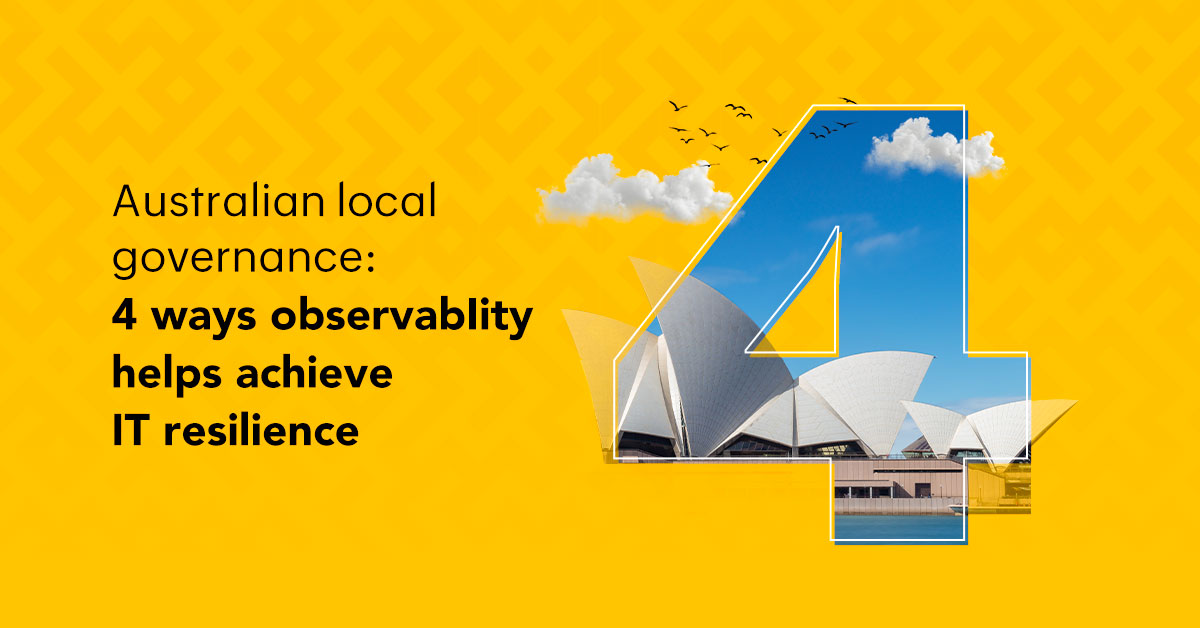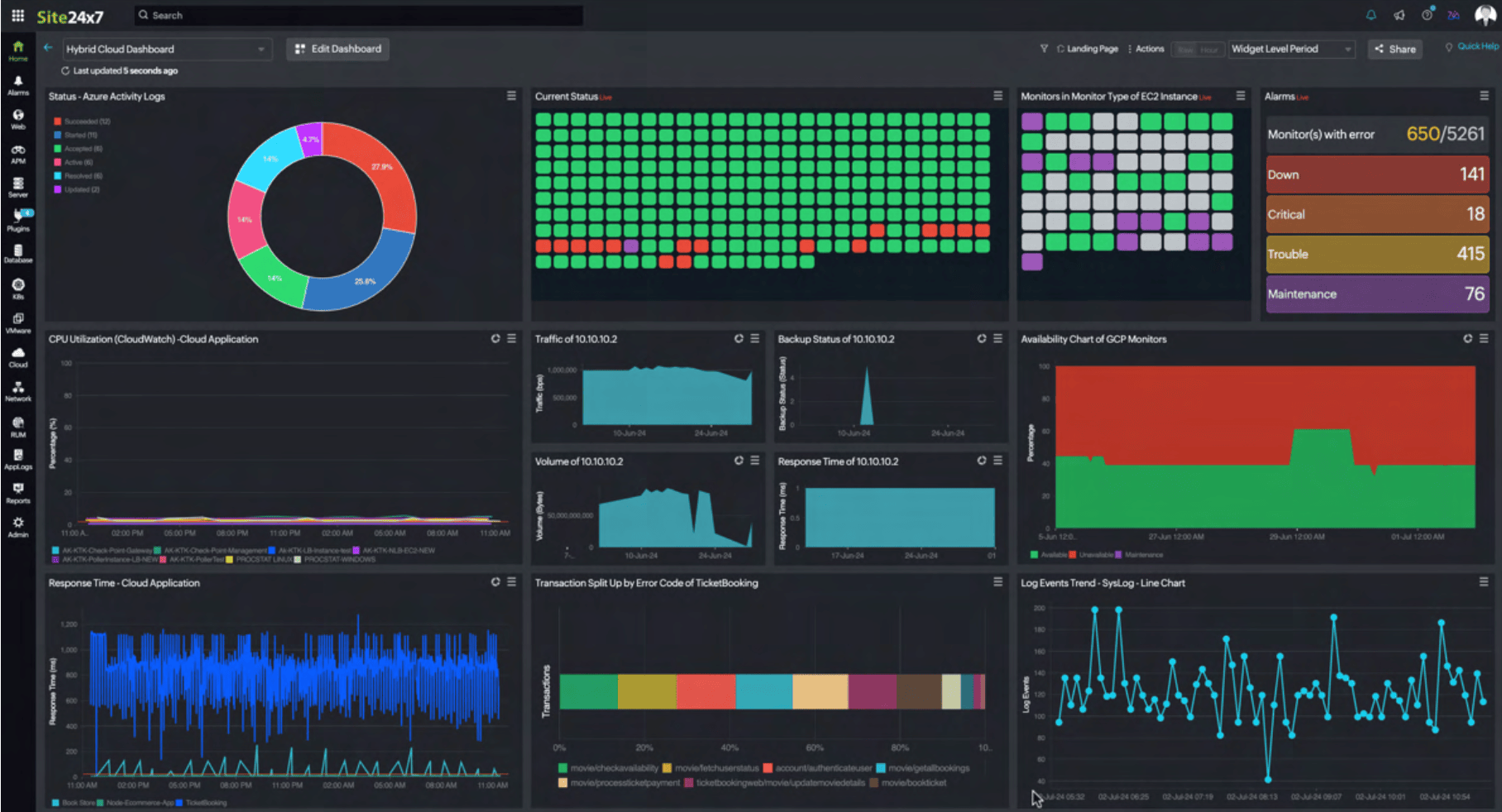Australian local governance: Four ways observabIity helps achieve IT resilience

Australian city councils rely on a variety of computer applications, information websites, and service portals to help run the civic infrastructure and essential citizen services.
Typically, Australian city councils operate a hybrid IT infrastructure that is a mix of both on-premise legacy applications that have passed the test of time and several modern cloud platform-based deployments that work together.
Typically, Australian city councils operate a hybrid IT infrastructure that is a mix of both on-premise legacy applications that have passed the test of time and several modern cloud platform-based deployments that work together.
An era of fast-paced digital transition
Transitioning into the cloud-first era, Australian city council IT teams are also warming up to the potential of AI in aiding their IT operations to ensure high resilience (the ability to bounce back faster from outages and be highly reliable). AI has overcome the burden of inflated expectations following its hype cycle. AI is mature and usable in real-world IT applications, with a large scope of use in IT monitoring and the possibility of automating remediation actions.
Citizens expect their city council services to be digital-first, highly usable, with maximum speed and minimum performance issues, and trustworthy, as many financial transactions and documentation work are carried out online.
Monitoring signals and connectivity is not sufficient as Australian city council IT teams transition into the modern digital era. Apps and websites are expected to function at high speeds on a variety of devices holistically and interconnected with many external applications that work together seamlessly.
To ensure a highly functional IT experience for citizens, IT teams have to build a resilient IT stack that is completely visible across all its layers and numerous transactions. This allows them to pinpoint issues, track the root cause, and fix them in the shortest time possible.
Citizens expect their city council services to be digital-first, highly usable, with maximum speed and minimum performance issues, and trustworthy, as many financial transactions and documentation work are carried out online.
Monitoring signals and connectivity is not sufficient as Australian city council IT teams transition into the modern digital era. Apps and websites are expected to function at high speeds on a variety of devices holistically and interconnected with many external applications that work together seamlessly.
To ensure a highly functional IT experience for citizens, IT teams have to build a resilient IT stack that is completely visible across all its layers and numerous transactions. This allows them to pinpoint issues, track the root cause, and fix them in the shortest time possible.
The need for observability
IT observability is the extent an IT team can see how its systems work by examining the data produced within. Engineers rely on the pillars of observability—metrics, traces, and logs—to close all gaps and look through every layer of a complex IT system.
With a hybrid IT stack, Australian local governance management can benefit from IT observability. Comprehensive IT observability helps get a clear view of the entire IT landscape that traditional IT monitoring cannot provide. While monitoring is all about preset metrics and alerts that lead to a reactive approach to IT systems management, observability opens the windows to proactive problem solving and sharper and faster RCA. This develops a holistic understanding of a complex system through its many layers.
Observability helps IT teams understand how each layer interacts with each other, perform in-depth analysis, and make quicker and better decisions, to achieve better resource allocation, performance optimization, and to ensure end-user delight.
With a hybrid IT stack, Australian local governance management can benefit from IT observability. Comprehensive IT observability helps get a clear view of the entire IT landscape that traditional IT monitoring cannot provide. While monitoring is all about preset metrics and alerts that lead to a reactive approach to IT systems management, observability opens the windows to proactive problem solving and sharper and faster RCA. This develops a holistic understanding of a complex system through its many layers.
Observability helps IT teams understand how each layer interacts with each other, perform in-depth analysis, and make quicker and better decisions, to achieve better resource allocation, performance optimization, and to ensure end-user delight.
Four ways Australian city council IT teams can use IT observability to ensure IT resilience:
Handle expanding data volumes: As applications, networks, devices, and interconnected services are rolled out, they also introduce a larger volume of data that needs effective handling to make sense. With comprehensive logging, AIOps-led analysis of metrics, and distributed tracing, observability helps gain a contextual, meaningful, and real-time health of IT infrastructure at all times.
Overcome visibility challenges: Traditional monitoring only focuses on a specific IT operation, leaving blind spots and silos that do not translate to a holistic view. With observability, there is a convergence of metrics, traces, and logs with the sole aim of making sense of it together, which leaves no gaps in visibility.
Go from reactive to proactive IT operations: When issues are identified through monitoring tools, they are often identified after the damage has been done, as teams frantically collaborate to brainstorm, while disrupted operations have already led to social media outrage.
Use AIOps to transform monitoring: With AIOps on an observability platform, IT teams can look at trends over several days and put dynamic thresholds at work.
Dynamic thresholds study computing resource usage holistically and contextually, and flag only issues that matter, while factoring in seasonal and acceptable usage fluctuations, such as weekend traffic or a spike in user activity during natural calamities. For example, during the pandemic, the health website of the Australian government received about six million daily users, which was a 650% increase in activity.
AIOps helps DevOps look beyond the obvious reasons for such outlier events, converge insights from across your IT infrastructure, to unearth the root cause to fix it, so that such incidents don't impact performance in the future.
Overcome visibility challenges: Traditional monitoring only focuses on a specific IT operation, leaving blind spots and silos that do not translate to a holistic view. With observability, there is a convergence of metrics, traces, and logs with the sole aim of making sense of it together, which leaves no gaps in visibility.
Go from reactive to proactive IT operations: When issues are identified through monitoring tools, they are often identified after the damage has been done, as teams frantically collaborate to brainstorm, while disrupted operations have already led to social media outrage.
Use AIOps to transform monitoring: With AIOps on an observability platform, IT teams can look at trends over several days and put dynamic thresholds at work.
Dynamic thresholds study computing resource usage holistically and contextually, and flag only issues that matter, while factoring in seasonal and acceptable usage fluctuations, such as weekend traffic or a spike in user activity during natural calamities. For example, during the pandemic, the health website of the Australian government received about six million daily users, which was a 650% increase in activity.
AIOps helps DevOps look beyond the obvious reasons for such outlier events, converge insights from across your IT infrastructure, to unearth the root cause to fix it, so that such incidents don't impact performance in the future.
Choosing the right IT observability platform

While traditional monitoring helps perform basic system health checks, a comprehensive IT observability platforms such as Site24x7 helps local city council IT teams gain a deeper understanding of their IT systems. Site24x7 empowers IT teams at every level to proactively address issues, optimize performance, and ensure the resilience of their stack that delivers services reliably to all citizens.
Embracing AI-powered observability from Site24x7 can revolutionize service delivery, ensure citizen satisfaction, and drive efficiency at every level for the governments within their budgets. Site24x7 also provides security and trust at every level of data handled, with strict adherence to all data privacy laws.
Embracing AI-powered observability from Site24x7 can revolutionize service delivery, ensure citizen satisfaction, and drive efficiency at every level for the governments within their budgets. Site24x7 also provides security and trust at every level of data handled, with strict adherence to all data privacy laws.
Comments (0)